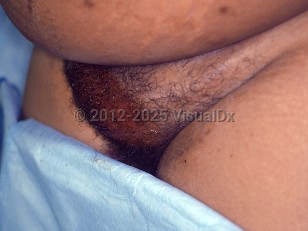Fournier gangrene
See also in: Cellulitis DDx,AnogenitalAlerts and Notices
Important News & Links
Synopsis

Gangrene results when the infection leads to thrombosis of the regional subcutaneous blood vessels. It is usually polymicrobial. Escherichia coli is the most commonly isolated organism. Fournier gangrene results from anorectal abscesses, pressure ulcers, trauma to the anogenital region (eg, surgical procedures, episiotomies, chronic urethral catheterization, pubic hair shaving), or spread of infection from nearby perineal structures (eg, perianal glands, Bartholin ducts, urinary tract infection). Individuals with diabetes mellitus, spinal cord injuries, or chronic alcohol use disorder or who are otherwise immunosuppressed are at increased risk for Fournier gangrene. Men are affected much more frequently than women.
Patients with Fournier gangrene are acutely ill. They are often thought to have cellulitis that is not responding to standard antibiotic therapy. There is commonly a paucity of cutaneous findings in the early course of the disease. Pain is out of proportion to physical findings. Patients present with pain, swelling, and erythema in the genital region that rapidly evolves to bullae formation and skin necrosis. Signs of systemic illness such as fever, lethargy, hypotension, and tachycardia are present; these may progress to multiorgan failure.
The mortality of Fournier gangrene is high. Treatment includes broad-spectrum intravenous (IV) antibiotics and immediate surgical debridement of infected and devitalized tissue. If you are considering this diagnosis, contact a surgeon now.
Codes
N49.3 – Fournier gangrene
SNOMEDCT:
398318005 – Fournier gangrene
Look For
Subscription Required
Diagnostic Pearls
Subscription Required
Differential Diagnosis & Pitfalls

Subscription Required
Best Tests
Subscription Required
Management Pearls
Subscription Required
Therapy
Subscription Required
Drug Reaction Data
Subscription Required
References
Subscription Required
Last Updated:05/01/2019

